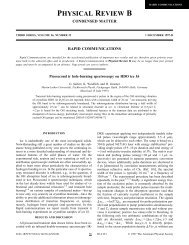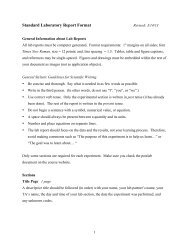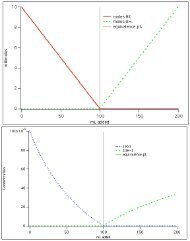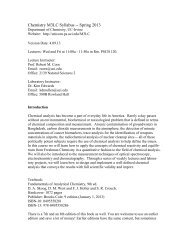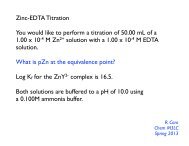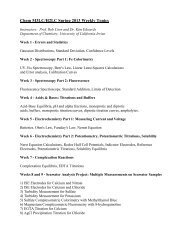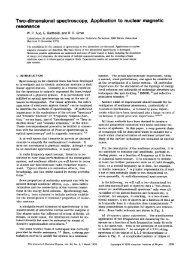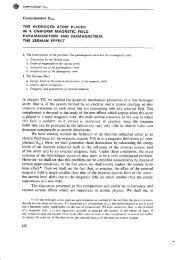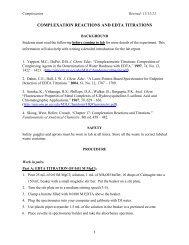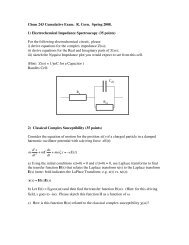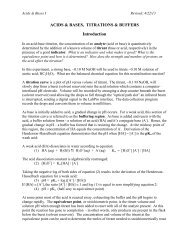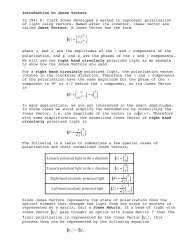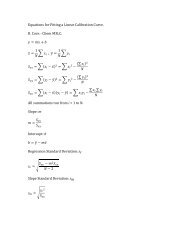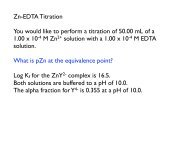Seawater Analysis Project - The Corn Group Unicorn Web Site
Seawater Analysis Project - The Corn Group Unicorn Web Site
Seawater Analysis Project - The Corn Group Unicorn Web Site
You also want an ePaper? Increase the reach of your titles
YUMPU automatically turns print PDFs into web optimized ePapers that Google loves.
<strong>Seawater</strong> <strong>Analysis</strong> Revised: 11/11/13<br />
SEAWATER ANALYSIS<br />
<strong>The</strong> final three weeks of this course will be the capstone analysis of seawater samples<br />
(collected by you!). In this final project, each pair of students will be assigned a<br />
technique for measuring the concentration of one or two ionic species found in seawater.<br />
In this project, you are asked to (i) research the technique, (ii) come up with a procedure<br />
for using this technique for measuring seawater samples, (iii) test this procedure on<br />
standard solutions that you have selected as well as synthetic seawater provided by the<br />
stockroom, and (iv) provide analyses for a series of seawater samples collected by your<br />
classmates.<br />
I. Initial Preparations (beginning week 7)<br />
Each lab pair will be assigned a particular type of measurement that will be used to<br />
analyze one or two types of ions in seawater. <strong>The</strong>re are eight measurement groups:<br />
1) Turbidity Measurements for Sulfate<br />
2) Turbidity Measurements for Potassium<br />
3) Sulfate Complexometric Colorimetry with Methylthymol Blue<br />
4) Magnesium Complexometric Fluorometry with 8-hydroquinoline<br />
5) EDTA and EGTA titrations for Magnesium and Calcium<br />
6) AgCl Precipitation titration for Chloride<br />
Your group will be assigned one of these eight measurements. You then must:<br />
i) determine what ion concentration range you expect to observe,<br />
ii) explain how the technique measures these ions and with what sensitivity (this includes<br />
some web research and gathering documents/protocols; the TAs can help you),<br />
iii) create a list of chemicals and equipment that you will need for the<br />
experiments. <strong>The</strong>se lists will be compiled by the TAs and given to the stockroom.<br />
Your first task is to create a Prelab document for Week 8 for your experiment in order to<br />
let the stockroom know what chemicals and laboratory equipment you will need. For<br />
more details, please see the handout:<br />
http://unicorn.ps.uci.edu/M3LC/handouts/<strong>Seawater</strong><strong>Analysis</strong>Prelab.pdf
<strong>Seawater</strong> <strong>Analysis</strong> Revised: 11/11/13<br />
II. Week 8: Testing Your Procedure<br />
This week, you need complete the following work:<br />
a. Create calibration curves or standards for your samples<br />
b. Make test measurements of the standard seawater sample to make sure that your<br />
methodology works.<br />
c. Write down all of the details needed to write a clear, complete Procedure for your<br />
analysis<br />
As a place to start, ask yourself the following questions:<br />
a. What type of measurements do I need to make a calibration curve or standards for this<br />
measurement technique?<br />
b. What concentration range do I expect to measure in seawater? Over what<br />
concentration range does my analytical technique work? (the answers to this will vary if<br />
you are using a Vernier spectrometer, an ion selective electrode or a pH meter).<br />
c. What other cations or anions in seawater will interfere with my measurements? How<br />
can I remove those interferences?<br />
d. How many samples will I be able to measure?<br />
III. Week 9: <strong>Analysis</strong> of <strong>Seawater</strong> Samples<br />
This week, having finished the calibration curves and initial procedure tests, you are<br />
ready to make careful measurements of some real seawater samples. Please bring a 1.0L<br />
bottle of seawater to add to the samples to be analyzed.<br />
<strong>The</strong> seawater samples will probably need some pre-processing before your analysis. Take<br />
a look at the seawater samples and ask yourself the following questions:<br />
a. If the seawater is not cloudy, can you do UV-Vis absorption spectrometry?<br />
b. What other pre-processing steps are necessary (pH? Ionic strength? Filtration? Ion<br />
exchange?)<br />
c. Compare with standard seawater samples and other techniques/groups to see if you are<br />
getting reasonable numbers.<br />
IV. <strong>Seawater</strong> <strong>Analysis</strong> Report<br />
For details on your report, please see the document:<br />
http://unicorn.ps.uci.edu/M3LC/postlabs/Week8PostLab.pdf<br />
Your <strong>Seawater</strong> <strong>Analysis</strong> Report will be due on Friday, December 6 at 11:00 am in your<br />
TA’s mailbox. A copy must also be uploaded by that time to turnitin.com.



